|
|
|
|
PAGE 1
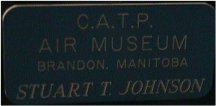
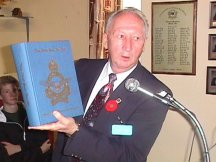
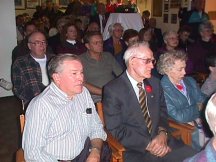
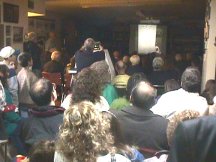
WORLD WAR I 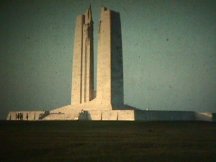
Vimy France ~ the Canadian Memorial to the 60 thousand Canadians who lost their lives in the Great World War, the War to end all wars, World War 1. 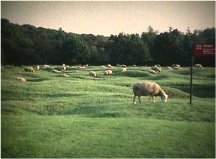
Vimy ~ The grass in the area is kept trimmed by the sheep. The ground still contains explosives from WWI as well as the remains of hundreds of soldiers who fought, died, and drowned in the mud. They still lose about one sheep a month due to the explosives being set off by the weight of the sheep. 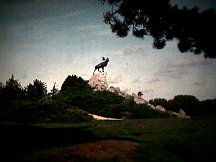
Beaumont Memorial - France: to the Newfoundland Regiment. Over 800 men went into battle - the following morning only about 78 answered roll call. The Caribou points directly to St. Johns, Newfoundland. 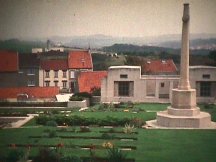
The Cemetery at Wimereau, France. John McCrea’s grave is to the immediate left of the Cross of Sacrifice. The stones lie flat because the soil shifts and they cannot be maintained vertically. 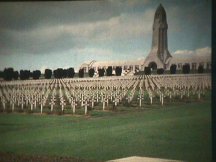
One cemetery near Verdun, France. It illustrates the futility of war. These stones represent a portion of the 120 thousand graves in this cemetery. WORLD WAR II 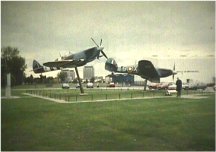
September 1, 1939: WWII began and soon after Germany walked over Poland, and then into Belgium, Holland and France. The free world held its breath while the Battle of Britain was fought and won by men flying the Hurricane on the right and the Spitfire(wearing D-Day stripes). Over 100 young Canadian pilots flew in the Battle of Britain and drove the German Luftwaffe from the skies of Britain. 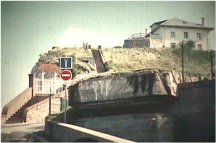
Later came the Dieppe Raid - August 19, 1942. The little Town of Puys shown here is where The Royal Regiment of Toronto was almost obliterated. The house above shows up in pictures of the raid and still remains. Note the large bunker to the immediate right, the machine gun half way up the stairs and the one in front of the house. 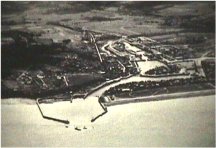
Air photo of Dieppe at the time of the raid. Debris still washes in from the sea in the tide. The harbour and town have changed little since that time… ...but are much friendlier now! 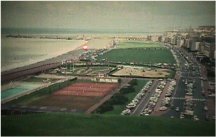
Dieppe today. At the time of the raid all the hotels and houses were full of machine gun positions and only a broad stretch of beach was left to cross under murderous gunfire. The remnants of a machine gun position remains at the brow of the green cliff near the centre of the picture. 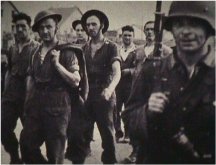
Prisoners taken at Dieppe. Nearly every town in Canada was touched by this raid. The Canadian with his hat tipped back is a relation of Stuart Johnson. 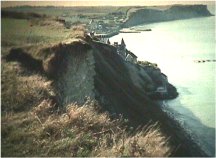
Taken above Arroanche France. The artificial harbour towed across from England still leaves its parts to indicate its position so long ago. (Gold Beach –Brt.) 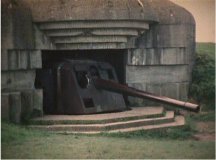
The Guns at Longues France. Gold Beach. They still remain but are bowed to the liberating Allies. Three aircraft flown by Canadians as they carried the war deep into the heart of Germany. The Lancaster (Visit our Battle of Britain Memorial Flight site for many photos) 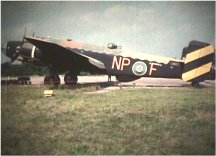
The Halifax 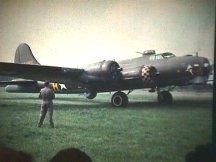
The B-17 Flying Fortress (This one appeared in the movie, MEMPHIS BELLE.) 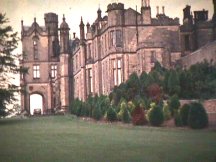
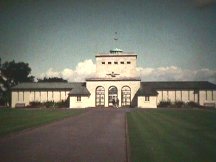
The Memorial to airmen of the British Commonwealth who flew out of England and have no known grave. Located at Runnymede, England. It contains the names of 20 thousand airmen with no known grave. There are six of these memorials around the world including the one in Ottawa. The total number of airmen without known graves is over 33 thousand. Runnymede in where the Magna Carta was signed in 1215, giving us our present day laws and freedoms. 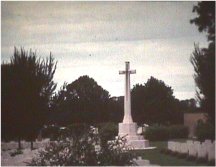
Dieppe Cemetery: The stones in the centre are of the men killed in the raid. Along the right are the graves of airmen. Almost out of the picture on the left are Free French graves - men who fought for the Allies. 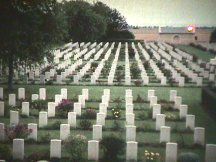
Beny Sur Mer Cemetery: Just beyond the building you might detect a different blue colour. This is Juno beach where the Canadians landed. TO PAGE 2 |
PAGE 2
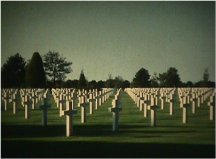
Above 0maha Beach - a D-Day beach. One of the two American invasion beaches. It was later called "Bloody 0maha.” Omaha Beach U.S. Cemetery:
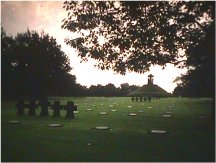
La Cambe, France ~ A German Cemetery containing 22,000 Graves. Men who died following a cause that went terribly wrong. The significance of the groups of 5 stones is unknown. 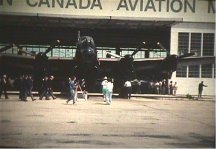
The Mynarski Lancaster in Winnipeg on its maiden flight - after Restoration. Mynarski died of burns trying to save his trapped tail gunner. The strange part of the story is that when the burning aircraft hit the ground the tail turret popped out and the tail gunner survived with only a few scratches. 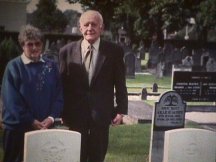
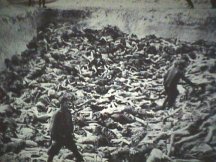
Bergen Belsen, Germany: Here the German SS who were responsible for the deaths of the prisoners are made to bury the dead in pits for fear of the spread of disease among the few that survived. 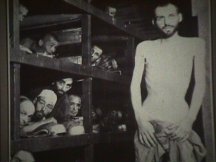
Bachenwald Death Camp: This shows the sleeping conditions in the camp. The man in the second row 4th from the left is Klei Weisel. He is still alive but his father died in this camp. 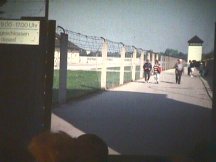
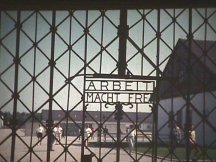
Main entrance for prisoners at Dachau. Words in the fencing roughly translated mean "Work makes you free." The only way to freedom was up the chimney in the crematorium! Dachaua was built in 1933 to house 5,000 prisoners. In 1945 at liberation it held 30.000. 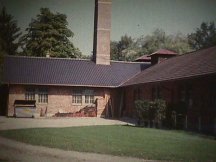
Crematorium at Dachau. Beware of Buildings with square chimneys in Germany. All death camps had them. There were no gas chambers here but starvation, brutality, and shootings achieved the same end. 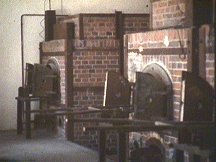
Dachau Crematorium: Where thousands were cremated. One of those was the famous French underground spy Madelaine. The plaque on the wall at the left honours her. 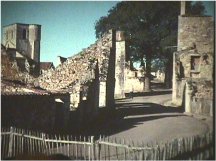
The Little town of Oradour Sur Glane, France where the German SS surrounded the town, called all the people to the village square, sent the men to the barns and sheds, women and children to the church and burned all the buildings killing 642 people. It was later discovered that the wrong town had been chosen for this orgy of killing. It stands today as a shrine. (It was dynamited after the killings.) 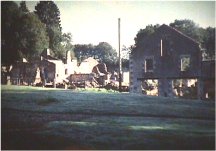
Oradour Sur Glane, France: Core remains. This is the church where one lady managed to jump out the window and was not discovered. She lived to tell the story. Oradour is about 25 Kms from Limoge, France. 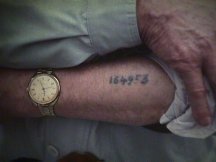
The prison number tattoo on the arm of a survivor of the Death Camp at Ebensee, Austria. He received it at age 14 while a prisoner at Auschwitz, Poland He is speaking to school children of his time in this camp. He was brought here at the age of 14-15. He did not return to Poland after the war but lives in Ebensee with his Austrian wife and 5 children. 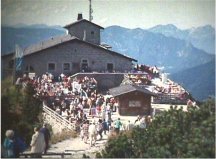
Hitler’s Eagles Nest in the Bavarian Alps: It is now a restaurant in the beautiful surroundings above Berchtesgaden, Germany. Think of the inhuman plans that were developed in this beautiful area. 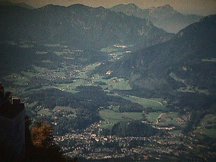
The town of Berchtesgaden, Germany lies below the Eagle's Nest. 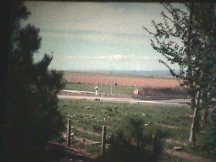
View from Calais Cemetery: Across the channel you can see the White Cliffs of Dover England. 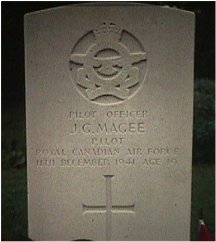
The grave at Scopwich of John Gillespie Magee Jr., an American who flew with the RCAF (as did 6000 other Americans). He wrote the poem High Flight which is a famous poem from WWII. He was killed in a mid-air collision at 19. 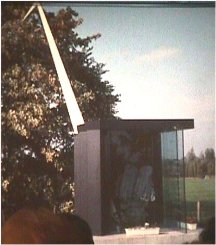
BACK TO PAGE 1 |
|
PART 2 of this feature: SCRIPT BACK TO OUR MONTHLY MILITARY WEBZINE CONTENTS PAGE As You Were . . .
 . .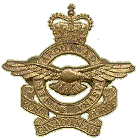 
Webmaster: William G. Hillman BILL & SUE-ON HILLMAN ECLECTIC STUDIO Editor and Webmaster Bill Hillman ~ Copyright 1996-2021 |